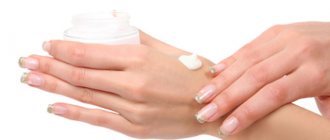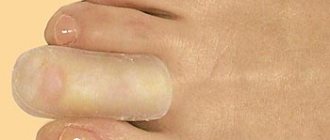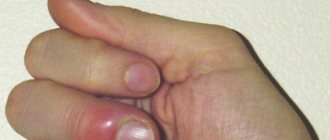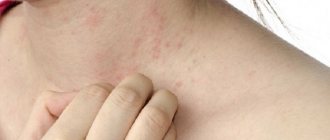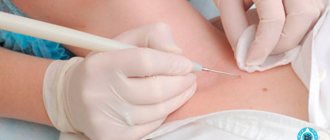Causes
The most harmless reason that your skin between your toes is cracking and peeling is improperly selected shoes. This phenomenon is typical for girls who, in the race for fashion, can neglect comfort and wear narrow shoes that negatively affect the foot. There are other reasons for the appearance of this disease:
- Athlete's foot. A very common fungal disease, the main symptoms of which are cracks in the heels and between the toes, accompanied by severe itching, peeling, redness and an unpleasant odor. In advanced forms, the nail plates may be affected, and the wounds may crack until they bleed. Infection usually occurs in bathhouses, gyms and public showers.
- Rubromycosis of the feet. Also very common is fungal infection, localized between the toes, on the heels and nail plates. The main symptoms are burning, weeping, cracks and itching in the area of the interdigital folds. In advanced cases, peeling of the skin and bleeding in the area of the lesions may occur. Infection occurs after personal contact with a patient and through bath accessories.
- Candidiasis. Very rarely, but still there are known cases where yeast fungi have spread from the genitals and mucous membranes to the feet and nail plates. Manifestations of candidiasis are accompanied by dry skin, which constantly cracks and peels. Sores form between the toes and on the folds of the feet.
- Allergic reaction. It is not often that you see manifestations of eczema or contact dermatitis on the feet, but it does happen, especially in young children. Synthetic shoes or socks can be an allergen. Distinctive symptoms are the appearance of many small blisters in the interdigital folds and on the foot, burning, redness and severe itching.
We also cannot exclude the possibility of peeling and sores between the toes due to hyperhidrosis of the feet or excess weight. Even vitamin deficiency can cause the skin in the folds of the foot to crack.
What does fungus on your toes look like?
First, it all starts with severe itching, which manifests itself most often in the evening or after a small amount of moisture gets on the surface of the skin. Any intake of liquid activates fungal spores. It may itch only between the toes, or the unpleasant feeling covers the entire surface along with its plantar part. If the patient does not respond to this symptom in any way, then after 5-7 days the following signs of a pathological condition of the skin of the legs will appear:
- the skin of the interdigital space becomes constantly wet;
- a red crack appears between the fingers, from which liquid is released;
- feet smell unpleasant even after swimming;
- the skin becomes covered with keratinized particles and peels off;
- fingers become red and swollen;
- Painful sensations accompany the itching.
what fungus looks like on the toes in the photo
The next stage of the disease is the spread of mycosis to the nail plate of the fingers, and deepening into its structure. As a result of this process, the nail is completely destroyed and begins to look like a fragment of old yellow laundry soap. It constantly crumbles, and it is impossible to cure it. There is only a radical method of therapy, when the nail plate is surgically removed and a new one grows in its place. But this treatment method will not have a positive long-term effect if nothing is done about the underlying fungal infection between the toes.
Diagnosis and treatment
It is very difficult to independently determine the cause of the appearance of cracks between the toes and on the foot, since even experienced dermatologists do not always have enough face-to-face examination to immediately make an accurate diagnosis and distinguish, for example, athlete's foot from rubrophytosis. If the symptoms do not go away within 2-3 days, and the wounds only increase in size, then it is better not to self-medicate and make an appointment with a dermatologist.
At the initial stage, athlete's foot can be cured with local medications, such as:
READERS RECOMMEND!
An easy way to get rid of Itching and Irritation! The result will not be long in coming! Our readers have confirmed that they use this method successfully. After carefully studying it, we decided to share it with you.
- Clotrimazole – 3 times a day for 7-10 days;
- Terbinafine – 2 times a week;
- Miconazole – 2 times within 1 week.
A combination of imidazole ointments and hydrocortisone is common. In advanced stages or patients at risk, systemic therapy using modern, synthetic antifungal drugs can be prescribed.
Rubromycosis of the feet is usually treated with antifungal agents for external use:
- Nizoral cream;
- Mycozoral ointment;
- Batrafen solution and ointment;
- cream and solution Exoderil, etc.
Regardless of the type of fungus, a prerequisite for successful recovery are:
- treatment and disinfection of shoes;
- processing of linen (socks, sheets);
- use of powder and powders;
- refusal to visit public showers, swimming pools and baths at the time of treatment;
- wearing only your own shoes and slippers.
- IMPORTANT TO KNOW! The people were stunned! Nail fungus will dry out to the root if you apply regular...
>>
You can get rid of candidiasis on the legs with the help of azole and triazole antifungal drugs:
- Itraconazole;
- Fluconazole;
- Ketoconazole.
If cracks and peeling between the toes are caused by foot hyperhidrosis or an allergic reaction, then it is necessary to treat the underlying disease. Many doctors claim that people who have problems with excess weight and severe sweating of the feet are several times more likely to encounter hyperhidrosis and fungal diseases.
One of the causes of malaise is a fungal infection. If it itches between your toes, then ointments, tinctures, and herbal baths will help eliminate the discomfort. It is necessary to treat the skin with antiseptics more often, to be treated for fungus or allergies.
Treatment methods
Diaper rash must be treated promptly and comprehensively. To achieve a high therapeutic effect, drug therapy must be supported by folk remedies. The main thing is to follow the doctor’s recommendations and not self-medicate.
Even a “neglected” fungus can be cured at home. Just remember to apply once a day.
Medical therapy
The main goal of drug therapy is to eliminate the source of diaper rash.
- If the cause of the disease is a fungus, the patient is prescribed external antimycotic ointments (Exoderil, Bifosin, Climbazol).
- For hyperhidrosis, it is recommended to use talc, Teymurov's paste, Levomekol ointment, and zinc-based creams with a drying effect.
- In severe stages, healing ointments (Lorinden, tar pastes, Locacorten-vioform) help well. Cream with bepanthol or sea buckthorn oil quickly restores damaged skin.
Lorinden helps get rid of severe diaper rash
In the treatment of diaper rash, it is necessary to use antiseptic liquids - furatsilin, potassium permanganate solution, hydrogen peroxide. Such drugs disinfect and dry the skin, which helps stop the infection.
Herbal baths
You need to mix equal amounts (100 g each) of crushed oak bark, chamomile and yarrow. Pour all ingredients into 300 ml of hot water and cook in a steam bath for 10–12 minutes. When the broth has cooled, you need to strain it and pour it into a bowl of warm water. Do the procedures before going to bed, after which you need to dry your feet with a towel and treat them with ointment or spray for diaper rash.
Oak bark baths relieve itching and irritation
Baths with herbal decoction help remove red spots, relieve itching and burning. Thanks to the simultaneous influence of several medicinal plants, the regenerative function of the epidermis is improved and cracks heal.
How to get rid of diaper rash with flax seeds
Brew 3 tbsp. l. flaxseeds in boiling water, grind everything into a paste. When warm, apply the mixture to the skin between your fingers 1-2 times a day. This method reduces pain and inflammation. The duration of treatment is until the diaper rash disappears completely.
Flax seeds effectively relieve diaper rash
Lotions with eucalyptus decoction
Pour crushed leaves of the plant (3 tablespoons) into 350 ml of hot water and boil in a water bath for 3-6 minutes.
Eucalyptus decoction helps relieve skin inflammation
Soak cotton pads in the cooled liquid and apply to sore spots. The lotions must be kept on problem areas for 5–8 minutes.
A remedy made from eucalyptus leaves relieves inflammation, eliminates redness and prevents the development of infection.
Other means
Aloe, pumpkin or plantain juice helps fight diaper rash between the toes in children. You need to lubricate the injured areas several times a day. This will help avoid irritation and stop the development of cracks.
To quickly eliminate inflammation, itching and burning, you can use the following methods:
- Wipe diaper rash several times a day with a weak solution of iodine (3-5 drops of iodine per 100 ml of boiled water);
- take soda baths (50 g of soda per 2 liters of warm water);
- make compresses from fresh leaves of dandelion, coltsfoot, alder;
- wipe diaper rash with sunflower oil, which must first be boiled for 5 minutes in a steam bath and cooled to room temperature.
Soda baths are a simple remedy for combating diaper rash on the legs.
Causes of itching and peeling between toes
The skin of the foot becomes affected and cracks due to fungal diseases (dermatomycosis). Typically, itching of the fingers and peeling appear asymmetrically - on one leg more than on the other.
Fungal spores land on the feet, penetrate through the shoots into the stratum corneum of the skin and feed on protein (keratin). Parasites secrete metabolic products and toxins that suppress local immunity, cause allergic reactions and inflammation.
Important! With high humidity, fungal spores in the patient's skin flakes can remain viable in the environment for several weeks.
There is an increased risk of contracting ringworm in people suffering from circulatory disorders in the legs and diabetes. The fungus also threatens those who sweat a lot and take antibiotics. People with weakened immune defenses are more susceptible to infection.
Cracks and peeling on the feet appear due to a deficiency of vitamins and zinc in the body. For normal metabolism in the skin, retinol, ascorbic acid, tocopherol, and B vitamins are necessary.
If discomfort in the toe area occurs due to allergies, then antihistamine drops Fenistil, Zyrtec or Zodak will help. They quickly eliminate itching and redness and act for 6–12 hours. Allergic reactions on the skin of the toes are caused by the materials from which socks, shoes, and floor coverings in the house are made.
Causes and signs of cracks between toes
The problem of dry and cracked feet affects about 1/3 of all people on the planet. Sick legs cause moral and physical discomfort and look untidy. The peak of exacerbation occurs in the summer.
Why does the skin between the fingers begin to burst? There are a number of reasons for the development of this symptom, which are divided into two categories.
External reasons:
- direct contact of the skin of the feet with the environment: sand, dust, water, hot air dry the skin, cause dehydration and loss of elasticity;
- tight, uncomfortable shoes or made from artificial, non-breathable materials. Causes circulatory problems, feet remain damp;
- violation of hygiene standards in foot care;
- Foot fungus is a common reason why the skin begins to peel and crack.
Internal factors:
- obesity;
- diabetes;
- lack of vitamins A and E in the diet;
- pathologies of the thyroid gland;
- pregnancy;
- allergic reactions;
- hyperhidrosis of the feet.
If you are unable to independently determine the cause of cracks between your toes, contact a medical facility.
Only eliminating the source will help restore foot health. Signs:
- If peeling or cracks appear between the fingers, and the nails turn yellow and peel, then this is a fungal infection. The disease is dangerous, therapy is carried out under the supervision of a doctor.
- If the skin of the feet begins to dry out and peel, diabetes may develop. Diabetic patients suffer from serious dermatological problems as a result of impaired water metabolism. Against the background of crack disease, other wounds heal for a long time and painfully.
- The skin can crack and peel off as a result of a lack of vitamins or an imbalance in nutrition. Recovery requires a long course of vitamin and mineral complexes.
A symptomatic picture of the appearance of cracks: the finger begins to hurt, peel, itch, turn red, a blister may appear, and then in its place an oozing wound.
We recommend reading
- How to restore cracked toe skin at home
- The skin on the legs dries and peels: reasons and what to do
- Dry skin on a child’s legs: causes, methods of treatment
Mycosis between the toes
An insidious fungus penetrates the epidermis, begins to multiply, and releases the products of its metabolism. At first, only a slight itching is felt between the fourth and fifth toes. Then the skin becomes swollen and peels off.
The main symptoms of the interdigital form of fungus:
- Itching, redness, burning.
- Peeling, whitish scales, cracks.
- Burning, sometimes pain caused by skin damage,
- Small bubbles, erosions, wounds.
The very first noticeable symptom of fungus between the fingers is persistent itching, which is felt more strongly after water procedures. Heat and sweating increase irritation and contribute to the deepening and expansion of the lesion.
Important! In the absence of treatment and weak local immunity, the infection spreads to other areas of the foot.
The dyshidrotic form of foot fungus is manifested by the formation of blisters between or under the toes. After contamination of cracks or burst blisters, a bacterial superinfection often develops, which produces an unpleasant odor from the feet.
Drugs from the pharmacy for the treatment of interdigital fungus
In the initial stages of the disease, symptoms disappear after 2–4 weeks with regular application of special ointments and good foot care. If the itching between the toes does not go away, then a dermatologist will tell you how to treat chronic mycosis. In the later stages, in addition to external therapy, doctors prescribe medications internally.
Modern pharmaceutical products for external treatment of interdigital fungus:
- Povidone-iodine is a solution and ointment with iodine without alcohol. Antiseptic, acts on bacteria, fungi, viruses. Disinfects the skin and prevents superinfection.
- Mikoderil - cream and solution with naftifine. It has a fungicidal effect on pathogens of interdigital mycosis and reduces the risk of bacterial superinfection. Eliminates itching, burning and inflammation. The course of application is from 2 to 8 weeks (if necessary).
- Fungoterbin - cream, gel and spray with terbinafine. Has a fungicidal effect (kills fungus). Course of application - 1 week.
- Bifosin - cream, powder, solution, spray with bifonazole. Acts on a large group of pathogens of dermatomycosis (broad spectrum of action). Duration of treatment and prophylaxis is 3 weeks.
The choice between solution, spray, ointment or cream depends on the condition of the feet and other circumstances. Antifungal gels and powders are best for those with itchy and sweaty toes. For those with a dry form of mycosis with pronounced thickening of the stratum corneum, it is better to use fungicidal lotions, creams and ointments. The spray is convenient for treating a large area of skin.
Sulfur, sulfur-salicylic and sulfur-tar ointments quickly help those whose feet begin to itch. These are cheap medicines, they effectively relieve itching, heal the skin on the foot and act against fungus.
Sulfur and tar have long been used for lichen and various fungal skin infections in humans and animals. The disadvantages of these products are a strong odor and a possible negative impact on health, especially for children.
How to quickly cure itching between the toes: pharmaceutical ointments and folk remedies
Irritation and itching between the toes may appear due to adverse environmental influences, but more often they are a manifestation of the disease. This unpleasant feeling is often accompanied by other symptoms: itchy, flaky, wet or peeling skin on the feet, blisters, blisters or painful cracks appear. If you do not pay attention to the problem, you will have to undergo treatment for a very long time in the future. In order to know which medications and folk remedies to use in each specific case, it is necessary to accurately determine the cause of the disease.
Treating interdigital fungus and itchy feet with home remedies
Traditional treatments are effective when used regularly and combined with good foot care. Folk remedies are attractive for their low cost and ease of use. Can be used independently and during treatment with medications.
The enemies of microbes on the skin are baking soda and vinegar. These substances change the pH, and therefore act on the causes of itching and unpleasant odor: too active proliferation of fungi and bacteria. A solution of kitchen and sea salt with the addition of iodine has a strong disinfectant and antiseptic effect.
Use of folk remedies for fungus:
- Do foot baths daily, adding 2 cups of salt and 1 tsp to 2 liters of water. soda
- Keep your feet in the solution for 20-30 minutes, then dry well with a soft towel.
- Alternate foot bath products during the week: salt solution, soda, vinegar, herbal infusion.
- Treat the skin of your feet with strong brewed tea and 9% table or homemade apple cider vinegar.
- Apply celandine oil or propolis tincture to clean, dry spaces between the fingers.
Water procedures using sulfur and tar soap help in treating fungus between the fingers. Afterwards, dry the affected area thoroughly with a disposable towel and apply ointment or tincture.
Helpful Tips:
- Resist the urge to scratch between your fingers, because the fungus will further advance through scratches, scratches and microcracks.
- If it itches between your fingers, treat the skin with calendula tincture, hydrogen peroxide, and iodine.
- Change your socks every day and wipe the inside of your shoes with vinegar or rubbing alcohol to prevent re-infection.
- Use herbal infusions for foot baths: St. John's wort, mint, chamomile, sage, lavender. Proportions of raw materials and water - 2 tbsp. l. for 200 ml.
- Make a solution for treating the skin of your feet from a decoction of 4-5 tbsp. l. oak bark in 1 liter of boiling water. Heat for 10 minutes, cool to 40°C and add a little lemon juice.
- Prepare an ointment from dried and ground lemon peel with Vaseline. Take one tablespoon of each ingredient, mix, apply to toes and feet, cover with cling film and put on socks.
Proper skin care is an important part of treating itching and flaking. You need to use scrubs and cosmetic nourishing creams for your feet, paying no less attention to them than to your face and hands.
Excerpts from TV shows about foot fungus
"About the most important thing"
"Live healthy"
Related articles: comments powered by HyperComments
Many people face the problem of cracking skin between their toes. This is a truly unpleasant condition, since cracking of the skin is usually accompanied by itching, flaking and, of course, discomfort and even pain while walking.
In fact, the appearance of cracks between the fingers can be caused by many factors:
- In some cases, skin cracking is associated with wearing uncomfortable shoes;
- Quite often, people encounter this problem in the summer, when they walk barefoot a lot - skin prone to dryness quickly loses moisture and begins to peel;
- Sometimes cracks are an allergic reaction to soap, cosmetics, or even shoe fabric - in such cases, rashes, eczema and itching appear on other parts of the body;
- Less commonly, this problem is associated with disruption of the normal functioning of the endocrine glands;
- The reason may be vitamin deficiency - a deficiency of vitamins primarily affects the condition of the skin.
- However, in most cases, the skin between the toes cracks due to a fungal infection. This disease has its own name - mycosis. The fungus can be picked up through contact with an infected person, or when visiting public places such as saunas, baths, swimming pools, etc. People with weakened immunity and problems with the endocrine system are more susceptible to fungal diseases. This disease is accompanied by severe itching and burning.
With such symptoms, it is very important to consult a doctor in time. It is almost impossible to independently determine the cause of skin cracking. After a series of tests and examination, a specialist will be able to correctly diagnose and prescribe treatment.
Of course, the chosen therapy directly depends on the cause of the disease. For example, if the skin between the toes cracks as a result of vitamin deficiency, the doctor will prescribe multivitamin complexes.
As for fungal diseases, today there are many appropriate drugs. You can use special gels or ointments that accelerate regeneration processes, inhibit the proliferation of pathogenic microorganisms, and also relieve the main symptoms, including itching and burning.
Remember that you should never ignore the problem. After all, cracks, especially deep ones, are excellent gateways for infection. Without treatment, infection, inflammation and other unpleasant complications are possible. If we are talking about a fungal disease, then the infection can spread to the nail plates, causing them to separate and turn yellow. The help of a specialist is simply necessary here.
Some tips:
You can use vegetable oil. In the evening, before going to bed, rub the oil into the skin on your feet and put on thin socks. In three weeks everything will pass, but for prevention I do this procedure once a month. **************************************** **************************************** ****************************
Helps well:
Talc is a fairly good antiseptic and does not dry out even children's skin; it is usually used to reduce friction. **************************************** **************************************** ****************************
Vitamins A, E in capsules. They are inexpensive, up to 20-50 rubles for 10 capsules, in my opinion. You crush the capsule and lubricate the cracks, it helps. You can drink more, but suddenly there will be an allergic reaction, although it would be strange if it happens, so external use is not bad. **************************************** **************************************** ****************************
for 25 grams of glycerin, add 1 tablespoon of vodka, 1 teaspoon of 10% ammonia, lubricate your feet at night, wear cotton socks. Make foot baths with salted water, then lubricate your feet with olive or sunflower oil, put on socks, and leave until the morning.
*********************************************************************************************************************************
One granny advised making masks from fresh strawberries. Fresh strawberries were laid out on a cloth, wrapped on the soles of the feet, on top of the cylophan and in the sock, overnight.
**********************************************************************************************************************************
Heated vegetable oil can help your problem. It is recommended to take baths from it before bedtime. After the procedure, put on knitted socks and stay in them until the morning.
**********************************************************************************************************************************
It could also be a lack of vitamin A. You need to put a piece of butter on about 100g of fresh carrots and eat it until the symptoms go away.
**********************************************************************************************************************************
Traditional medicine can help you treat fungus.
Nowadays there is a fairly extensive selection of various antifungal drugs on sale; with the help of these sprays and ointments you can quickly return the skin of your feet to its original condition. But this problem can be dealt with using simpler, and most importantly cheaper, methods. One of the proven folk methods is treatment with onions. Steam your feet in hot water; be sure to add baking soda to the water. Then apply onion paste to your toes and wrap your feet in plastic. Go to bed, and in the morning remove the plastic and wash your feet thoroughly. For complete treatment, the procedure is repeated two to three times.
There are also special masks that help solve this problem. One of the most popular is a mask using castor oil. Mix 0.5 tbsp. l. alcohol with 1 tbsp. l. castor oil and 2 tsp. chamomile decoction. After all the components are mixed, talc is added to them and a thick mass is made. Apply this mixture to cracks in the skin and leave for forty minutes. Then rinse off and lubricate your feet with nourishing cream.
But if home treatment does not give the desired result, and the skin is still cracking, then consult a dermatologist.
Dry skin between the toes due to exposure to the external environment, fungus or diseases of the internal organs can lead to the formation of small cracks in these places over time. Failure to solve the problem in a timely manner aggravates the situation: the cracks become deeper and the sensations become more painful. Why do cracks occur between the toes, how to treat them and how to prevent their formation?
Why do cracks occur between the toes?
There may be several possible causes of the problem, and in general they can be divided into two groups: external and internal.
External causes of cracks between the toes
- wearing tight, uncomfortable shoes, as well as shoes made of leatherette - in them the foot does not “breathe” well, blood circulation is impaired, the skin sweats, which subsequently bursts;
- contact of exposed areas of the skin of the feet with the environment in the summer: skin dried out from high temperatures loses its elastic properties, cracks in the most delicate places and takes a very long time to heal;
- Foot fungus is one of the most obvious reasons why the skin on your feet breaks. It manifests itself in the form of itching, increased sweating of the feet, diaper rash, and unpleasant odor. The growth of fungal bacteria is activated, usually in the summer;
- lack of proper care for the skin of the feet, especially in the warm season, when the feet are subject to particular aggression from the outside.
Internal causes of cracking skin between toes
A number of diseases can be accompanied by a symptom in the form of cracked skin between the toes:
- thyroid diseases;
- diabetes mellitus, which is characterized by dehydration and dry skin;
- improper diet, which lacks vitamins A and E, “responsible” for the softness, elasticity, firmness and silkiness of the skin.
If the cause of the problem is not obvious to you, you should consult a doctor before starting treatment. After all, if the external causes of cracked skin on the legs can be eliminated with the help of proper care and external treatment, then the internal ones necessarily require eliminating the original source that causes the appearance of unpleasant symptoms.
Treatment with pharmaceuticals
The most effective for treating burst skin between the toes, of course, are various pharmaceutical preparations in the form of creams, ointments, and gels. They quickly heal wounds, soften the skin, and prevent the formation of new cracks. A good effect is achieved by alternating 2-3 wound healing products.
Among such means we highlight the following:
- if cracks arise due to external factors, any pharmaceutical foot cream with a label like “Healing against cracks” will be enough to eliminate them. For example, Carmol, Dardia, Nutraderm creams, and foot creams with urea are quite effective;
- Betadine ointment gives a good result, and if you need a product from the “cheap and cheerful” category, then quite impressive results can be achieved using regular Vaseline or vinylin (Shostakovsky ointment);
- It may seem ridiculous, but the advice to use Zorka to heal cracked legs is quite realistic. To get this cream, you will have to go not to a regular pharmacy, but to a veterinarian - after all, “Zorka” is intended for the treatment of cracks in the cow’s udder. However, many have already experienced the effect of this product on their feet - and they are not overjoyed. The cream is very greasy and has an unpleasant smell - but you can be sure that there is nothing unnecessary in it, only what is needed for skin healing;
- In case of fungus, it is recommended to treat cracks with the help of special antifungal wound healing agents: Terbinafine, Termicon, Clotrimazole, Miconazole, Ketoconazole, Lamisil, etc. If local medications do not help, oral medications must be added to treatment. Remember that antifungal agents must be prescribed by a doctor;
- To treat cracks between the toes of diabetics, it is recommended to use the SixtuMed treatment line. This is a foot bath oil and balm specially developed for diabetic patients, containing plant components that have a pronounced antibacterial and antifungal effect. SixtuMed products perfectly nourish and moisturize the skin, heal cracks, and relieve irritation. Instructions for use: add SixtuMed oil to a bath of warm water (at the rate of 1 teaspoon of oil per 1 liter of water). After taking the bath, your feet should be allowed to dry without using a towel and SixtuMed balm should be applied to problem areas.
Folk remedies
Despite the availability of a sufficient number of special creams and ointments, folk methods of treating chapped skin on the legs are no less popular. In addition, greater effect can be achieved by combining these two methods.
Baths
So, before applying the cream, it is good to steam your feet in a healing and softening bath:
- grate ¼ bar of laundry soap on a fine grater, dilute the resulting shavings in 2 liters of hot boiled water and add 1 tsp. baking soda. Immerse your feet in the bath for 30 minutes;
- prepare a decoction of string and/or oak bark according to the instructions on the package. Dilute 2 cups of broth in 2 liters of hot water. Take a bath for half an hour;
- Calendula, coltsfoot, sage, and chamomile have similar wound-healing properties. Dilute the broth in the same proportions as in the previous recipe;
- A bath with boric acid is also good. To prepare it, you need to dilute 2 tsp. products in 2 liters of hot water;
- for fungus, it is effective to use baths with lemon juice or vinegar;
- Another effective antifungal folk remedy is black tea. Brew 6 tea bags in a liter of water - the tea bath is ready;
Be careful! If the cause of cracks is diabetes, steaming the skin of your feet with hot water is contraindicated. For warm baths, use special products for diabetics.
Baths must be done every night until the wounds are completely healed. After the bath procedure, you need to apply a special cream for healing cracks or any nourishing cream, Vaseline or badger fat to problem areas. If the cause of the burst skin is a fungus, antifungal agents are used.
At night, you can place cotton wool between your toes for better air access and faster healing of wounds.
Lotions and compresses
Lotions and compresses are more effective than baths due to the high concentration of ingredients. They should be used for deep cracks between the toes, which heal slowly and cause particular discomfort.
- crush 10 aspirin tablets and dilute them in 100 ml of ethyl alcohol. Add 25 ml of iodine and stir. Pour the resulting lotion into a dark glass container. Do lotions every day;
- Apply liquid honey to problem areas, wrap them in a bandage, put on cotton socks and leave the compress overnight. In the morning, rinse your feet with warm water and apply a rich, nourishing cream to the skin;
- pour boiling water over 5 tbsp. oatmeal, let brew for 10-15 minutes. Add 3 tbsp. olive oil. Divide the resulting mass into two parts and fill them into 2 plastic bags. Place the bags on your feet and keep them there for 2 – 2.5 hours. Wash your feet, lubricate with cream;
- Take half a glass of potato peelings and flax seeds, mix, pour ½ liter of boiling water. Cook the mixture until it has a mushy consistency, let it cool. Apply the resulting paste to your feet for 20 minutes, then rinse with warm water, let dry and lubricate the cracks with iodine;
- To treat fungus, use lemon lotions by diluting the juice of one lemon in 50 ml of water.
Ointments
Healing ointments for healing cracks can also be prepared at home. Pine oil is especially popular. To prepare it, you need to pour a glass of pine needles with a glass of boiling water. Boil the broth in a water bath for 30 minutes, let cool, strain. Add to the broth a tablespoon of butter softened at room temperature and 1 tsp. camphor oils. Lubricate deep wounds between your fingers with pine oil immediately after taking baths;
A remedy that increases the effectiveness of treating cracks between the toes is a foot massage with any vegetable or essential oil. It increases blood circulation, promoting rapid healing of wounds.
Prevention of cracks
Of course, it is easier to prevent a problem than to fix it. So if you know that the skin between your toes is prone to dryness and cracking, just follow these simple rules for daily foot care:
- watch your diet: it should be complete, your diet should include a sufficient amount of vitamins A (liver, garlic, wild garlic, dairy products) and E (nuts, herbs, red fish, vegetable oils);
- take proper care of your feet: take preventative baths 1-2 times a week, clean your heels of rough skin, apply foot cream every evening before bed and do regular foot massage;
- wear comfortable shoes made of natural materials, treat them with special antiseptics;
- after visiting (which it is advisable not to abuse) public baths and saunas, treat your feet with an antifungal agent;
- Get a hardware pedicure every 1-2 months.
During the hot summer period, many women suffer from the formation of calluses and cracking of the skin between their toes. Even thorough frequent washing and effective moisturizing do not help cope with this problem. Before resorting to more serious actions, it is advisable to determine the reasons that may provoke such a pathology.
Why does the skin between several toes crack?
The most likely and common cause of the defect in question is a fungal infection. In medicine, this type of mycosis is called epidermophytosis.
You can become infected with the fungus in public places such as a sauna, swimming pool, bathhouse, beaches, as well as through close direct contact with a sick person. The likelihood of mycosis increases if there are chronic endocrine, immune or digestive diseases, or a weakened cardiovascular system.
The main symptoms of epidermophytosis:
- redness appears on the feet;
- the skin between the toes cracks and itches;
- wounds and ulcers form;
- the epidermis in the heel area becomes very thick;
- at the base of the fingers the skin begins to peel off;
- The nail plates are affected (darken, turn yellow).
Of course, there are also less serious factors that lead to the skin cracking between the toes - the reasons are as follows:
- wearing tight shoes that do not allow air to pass through;
- insufficient hydration of the feet, especially after showering or swimming in ponds;
- deficiency of vitamins E and A;
- allergic reaction to soap, cream.
What to do if the skin between all the toes cracks and peels - how to treat the pathology?
For epidermophytosis, the doctor will most likely prescribe one of the effective local medications:
- Terbinafine;
- Exifin;
- Lamisil;
- Thermikon;
- Zalain;
- Terbizil;
- Fungoterbin;
- Terbix;
- Lamitel;
- Atifin;
- Batrafen;
- Mikonorm;
- Exoderil;
- Cyclopiroxolamine;
- Mycosporus;
- Terbized-Agio;
- Nizoral;
- Bifosin;
- Mifungar;
- Mycozoral.
Sometimes systemic remedies are also required if the skin between the toes has been cracking for a long time and severely - adequate treatment in such situations requires taking antifungal tablets:
- Mikosist;
- Fluconazole;
- Forkan;
- Diflucan;
- Flucostat;
- Mycomax;
- Nizoral;
- Fungavis;
- Itraconazole;
- Ketoconazole;
- Orungal;
- Candithral;
- Rumicosis;
- Itrazole;
- Irunin;
- Terbinafine;
- Lamisil;
- Onyhon;
- Fungoterbin;
- Exifin.
In addition to drug therapy, you need to carefully monitor foot hygiene, change and wash socks daily, and wipe your feet dry after washing.
Treatment
Why the skin of an adult’s legs peels off, a qualified doctor can already tell with a visual examination. Treatment will be prescribed based on laboratory tests, as well as depending on the cause that caused the peeling of the skin between the toes.
Simple moisturizing creams can eliminate peeling between the fingers, if there are no visible infectious diseases. Dry skin can be itchy and uncomfortable, but all you need to do is provide it with the nutrition it needs and maintain good hygiene.
It is very important not to get carried away with detergents, because there is a chance that the antibacterial soap you use so diligently can wash away the natural protective layer from the skin. This is why the epidermis dries out and begins to peel off.
Your toes will peel off due to a lack of vitamins, as mentioned above. To normalize the balance of nutrients, you need to take medications that stimulate the immune system and vitamin complexes. Retinol, Vitamin E, Imudon, Bronchomunal and Lykopid have proven themselves very well.
Antihistamines Tavegil and Suprastin will help relieve symptoms of an allergic reaction. These medications will also help relieve itching and burning, which are frequent accompaniments of the body's reaction to an irritant. If the skin between your toes peels due to a fungus, topical remedies will be prescribed, such as:
- Lamisil;
- Exoderil;
- Clotrimazole;
- Terbinafine;
- Mikospor.
All of the above products contain components that are active in the fight against different strains of fungus, as well as some gram-positive bacteria. By correctly applying external products to the surface of flaky skin, you will certainly get results.
If you notice that flaky areas are cracking and the skin is peeling off, revealing a red surface, it is very important to treat with antiseptics. A bacterial infection may develop in the affected areas. Treat the inflamed surface with salicylic alcohol, hydrogen peroxide or Chlorhexine.
